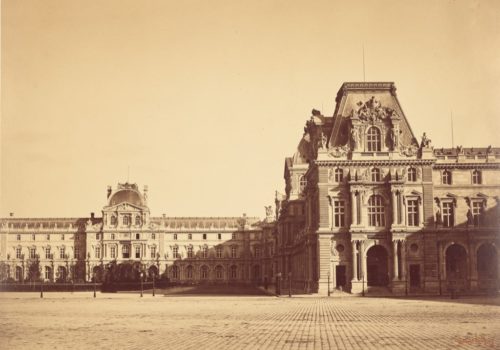It was Nadar who coined the phrase, “the primitives of photography” to designate the first generation of French photographers who experimented with new technical processes and created a body of images proper to photography. The Getty Museum in Los Angeles holds an exhibition devoted to those “primitives,” namely Édouard Baldus (1813–1889), Gustave Le Gray (1820–1884), Henri Le Secq (1818–1882), and Charles Nègre (1820–1880), concentrating on the twelve-year period marked by the first use of paper negatives in France. Real/Ideal: Photography in France, 1847–1860, curated by Karen Hellman, shows prints and negatives from the Getty Museum collection, including its most recent acquisitions, as well as international loans.
The exhibition emphasizes the wide range of technical experimentations involved in capturing, printing, distribution, and conservation of images. The decade in question saw the transition from the daguerreotype to paper negatives, and then to glass negatives. At the same time, printing methods improved, notably thanks to advances made by Le Gray; albums and illustrated journals were photography’s favorite media from the start, while concerns about image conservation prompted the use of more durable techniques, such as cyanotype and photogravure.
The core of the exhibition, however—consistently reflected in the contributions to the catalog—revolves around the tensions and paradoxes informing photography in the 1850s, at a point in its history before it attained its real status. Photography was considered to be, and was used as, a technique of mechanical reproduction of reality; however, its practitioners had more aesthetical aspirations and saw themselves as artists. The desire to reproduce reality down to the smallest detail went hand in hand with the ambition to endow the image with its own necessity and beauty, that is to say, in the idiom of the time, to “interpret” reality. The photographs and the negatives featured in the exhibition illustrate these two attitudes. Thus, the prints produced by the Heliographic Association in 1851, which aimed at documentation in the strict sense of the word, are displayed side by side with Gustave Le Gray’s famous seascapes which exemplify the ideal of the romantic sublime.
The place of these “primitives” in the history of photography has been recently subject to reassessments, and Real/Ideal is part of those efforts. The exhibition is arranged thematically and outlines the current state of research. The success of the exhibition and of the catalogue rests on a handful of subtle images of stunning beauty: a rock, the traces of a landslide, trees bordering a road, a plough, a smoked herring, a tree trunk. These images appear incredibly modern, a fact that can be explained historically: they go beyond the major genres and themes of academic painting and expand the field of what may be represented in art, thus endowing photography with autonomy and its own distinct style. In light of contemporary artistic production, these images may seem to some dull and dated, but only if we forget their radical character. We discover (but is it really news?) that the genius of photography is most often revealed in singularly banal images. Although they may not look like much, these photographs transmit the ultimate aesthetic experience: no frills, no idle talk, no headline-grabbing or scandal-mongering, no fuss, no market values—only sheer delight.
Hugo Fortin
Hugo Fortin is a photography critic based in New York.
Real/Ideal: Photography in France, 1847–1860
Getty Museum
1200 Getty Center Drive
Los Angeles, CA
From August 30 to November 27, 2016.
Exhibition catalog: Real/Ideal: Photography in Mid-Nineteenth Century France
Edited by Karen Hellman, with essays by Sylvie Aubenas, Sarah Freeman, Anne de Mondenard, Karlyn Olvido, and Paul-Louis Roubert.
240 pages and 212 color illustrations.
- Paul Getty Museum, August 2016. $59,95
















